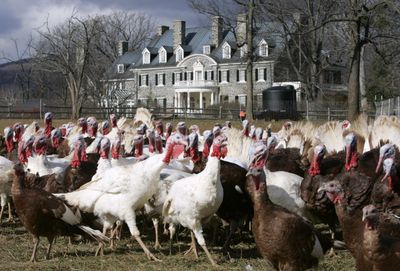Turkeys’ new pecking order
Farmers carving out a place for heritage breeds

UPPERVILLE, Va. – At Ayrshire Farm, hundreds of Midget White and Bourbon Red turkeys move in a feathered, gobbling mass on a wind-swept pasture overlooking Virginia’s horse country.
These birds have longer legs and narrower breasts than the beachball-shaped turkey that will end up on many Thanksgiving Day tables. What they lack in heft, however, these heritage birds make up for in flavor, proponents say.
They also make it up in price: a 20-pound certified organic turkey from Ayrshire Farm costs $180.
Heritage turkeys are at the forefront of a movement to preserve threatened breeds – some dating to the nation’s founding by Europeans and earlier – to ensure the continuation of ancient genetic strains and, yes, to get them listed on a chic restaurant menu or in a display case of a boutique butcher shop.
“One of the things we say is, you have to eat them to save them,” said Marjorie Bender, of the American Livestock Breeds Conservancy. “If we can give them their jobs back, then they’re not museum artifacts.”
The conservancy, based in Pittsboro, N.C., has compiled a list of more than 150 threatened and neglected breeds that reads like a passenger list on Noah’s Ark, including donkeys (the Poitou, which resembles Eeyore, the forlorn donkey in “Winnie-the-Pooh”), sheep and turkeys.
The idea is to save the breeds and preserve the diversity of farm animals, as well as the history they embody, Bender said.
Some of those traditions date to the Spanish and English settlers who first arrived on our shores.
They include the Pineywoods cattle, found primarily in Florida, Mississippi and Alabama; and Colonial Spanish horses, which include the Marsh Tacky. Chincoteague ponies, celebrated in the classic 1947 children’s book “Misty of Chincoteague,” are a diluted link to the Colonial Spanish.
Ayrshire Farm raised 412 turkeys this season, a large number considering the estimated 30,000 heritage birds produced in the U.S.
This Thanksgiving, Americans will buy 46 million standard Broad-Breasted Whites, the big-breasted bird preferred by the majority of Americans, according to the National Turkey Foundation.
The difference between a heritage and factory bird is extreme.
The standard commercial bird will be ready for the table in 18 weeks, compared with 26 weeks for the heritage bird; heritage birds forage, while the standard breed will live its short life before a feeding tray; and commercial birds cannot mate without human intervention.
A market-ready industry turkey is the equivalent of an 11-year-old child weighing 300 pounds.